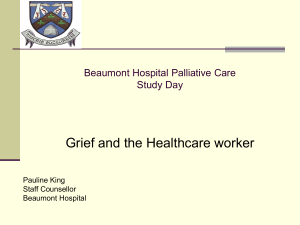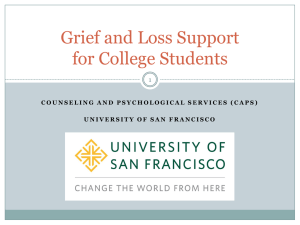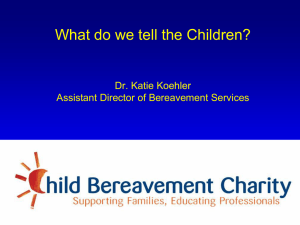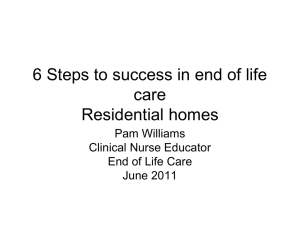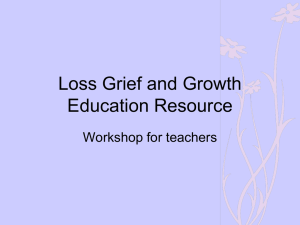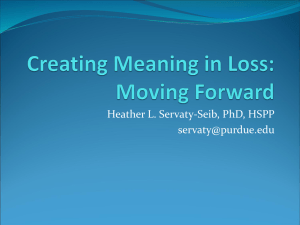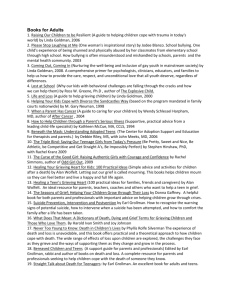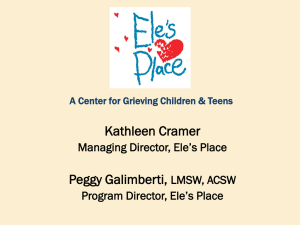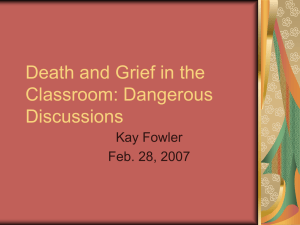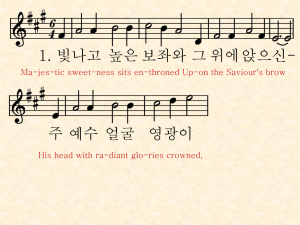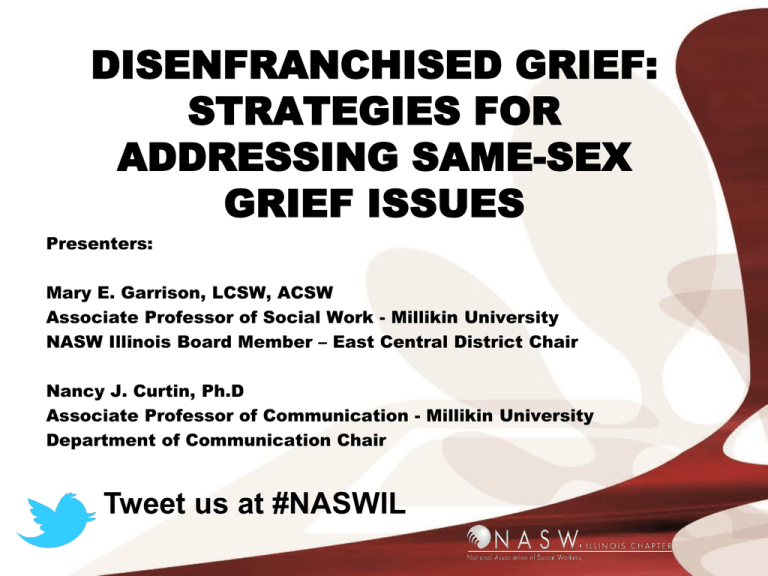
DISENFRANCHISED GRIEF:
STRATEGIES FOR
ADDRESSING SAME-SEX
GRIEF ISSUES
Presenters:
Mary E. Garrison, LCSW, ACSW
Associate Professor of Social Work - Millikin University
NASW Illinois Board Member – East Central District Chair
Nancy J. Curtin, Ph.D
Associate Professor of Communication - Millikin University
Department of Communication Chair
Tweet us at #NASWIL
Session Preview:
•
•
•
•
Historical Perspective
Case Study
Concepts & Case Connections
Strategies & Techniques
Historical Perspective:
• Focus on Gays
• Emerging Focus on Lesbians
• Our Focus Today: Gays and Lesbians
Case Presentation: Nancy & Jill
Disenfranchised Grief (DG):
• Conceptualization of Definition
• Examples
• Impact of DG on Same-Sex Couples
“Case Connections”
Same-Sex Grieving Partners:
Unique Factors
• Attitudes about Same-Sex Couples
Discrimination
Heteronormativity
• Role of Person & Relationship Disclosure
Internal
Definition of relationship
External
Degree of “Outness”
Same-Sex Grieving Partners:
Unique Factors
• Cause/Reason for Death
• Stigma
• Resource Availability
• Lack of effective/appropriate resources
• Support groups
• Counseling
• Professional Services
• Result = Disenfranchised Grief
Cultural Competence:
• Social work perspective
Assumptions
Use of language
Labeling/defining relationship
Reference to deceased
Centrality of relationship
Cultural Competence:
• Communication Perspective
Defining/Labeling the Relationship
Disclosing the Relationship (degree of
“outness”)
Identifying the Context of the Disclosure
Managing the Disclosure
Intervention Strategies: Same-sex
grieving partners
Language Use
Mirror client’s language with the relational
label & feelings.
Acknowledgement/Communication of DG
Provide context for client
Validate
Intervention Strategies: Same-sex
grieving partners
Validation of Loss
Avoid minimization of relationship and
feelings
Recognition and Identification of
Communication
Consider internal messages
Question external messages
References:
• Broderick, D. J., Birbilis, J. M. & Steger, M. F. (2008). Lesbians
grieving the death of a partner: Recommendations for practice.
Journal of Lesbian Studies (12), 2-3, 225-235.
• Doka, K. J. (1989). Disenfranchised grief. In K. J. Doka (Ed.),
Disenfranchised Grief: Recognizing the Hidden Sorrow (pp. 3-11).
Lexington, MA: Lexington Books.
• Hunter, S. (2011). Lesbian and Gay Couples: Lives, Issues, and
Practice. Chicago, IL: Lyceum Books, Inc.
• McNutt, B. & Yahushko, O. (2013). Disenfranchised grief among
lesbian and gay bereaved individuals. Journal of LGBT Issues in
Counseling, 7(1), 87-116. DOI: 10.1080/15538605.2013.758345.
• National Association of Social Work Standards for Cultural
Competence in Social Work Practice. (2001). NASW Press.
References:
• Petronio, S. & Durham, W. T. (2008). Communication privacy
management theory: Significance for interpersonal
communication. In L. A. Baxter & D. O. Braithwaite (Eds.),
Engaging theories in interpersonal communication: Multiple
perspectives (pp. 309-322). CA: Sage.
• Rack, J., Burleson, B., Graham, B., Holmstrom, A. (2007).
Bereaved adults’ evaluations of grief management messages:
Effects of message person centeredness, recipient individual
differences, and contextual factors. Conference paper-International Communication Association Annual Meeting, 1-41.
• VanDenBergh, N. & Crisp, C. (2004). Defining culturally competent
practice with sexual minorities: Implications for social work
education and practice. Journal of Social Work Education, 40(2),
221-238.
References:
• Walker, J.A. & Prince, T. (2010). Training considerations and
suggested counseling interventions for LGBT individuals. Journal
of LGBT Issues in Counseling, 4:2-17. DOI:
10.1080/155538600903552756
• Whipple, V. (2006). Lesbian Widows: Invisible Grief. New York:
Harrington Park Press.
• Wood, J. T. (2009). Gendered Lives. Boston, MA: Wadsworth
Cengage.


